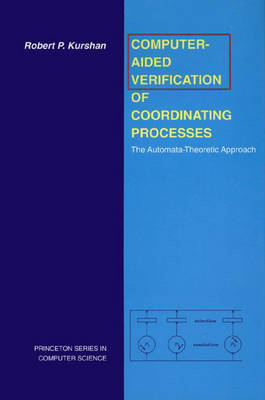
Computer-Aided Verification of Coordinating Processes
The Automata-Theoretic Approach
Seiten
1995
Princeton University Press (Verlag)
978-0-691-03436-2 (ISBN)
Princeton University Press (Verlag)
978-0-691-03436-2 (ISBN)
- Titel ist leider vergriffen;
keine Neuauflage - Artikel merken
Formal verification increasingly has become recognized as an answer to the problem of how to create ever more complex control systems, which nonetheless are required to behave reliably. This book develops the theory of automata-theoretic verification from its foundations, with a focus on algorithms and heuristics.
Formal verification increasingly has become recognized as an answer to the problem of how to create ever more complex control systems, which nonetheless are required to behave reliably. To be acceptable in an industrial setting, formal verification must be highly algorithmic; to cope with design complexity, it must support a top-down design methodology that leads from an abstract design to its detailed implementation. That combination of requirements points directly to the widely recognized solution of automata-theoretic verification, on account of its expressiveness, computational complexity, and perhaps general utility as well. This book develops the theory of automata-theoretic verification from its foundations, with a focus on algorithms and heuristics to reduce the computational complexity of analysis. It is suitable as a text for a one-or two-semester graduate course, and is recommended reading for anyone planning to use a verification tool, such as COSPAN or SMV.
An extensive bibliography that points to the most recent sources, and extensive discussions of methodology and comparisons with other techniques, make this a useful resource for research or verification tool development, as well.
Formal verification increasingly has become recognized as an answer to the problem of how to create ever more complex control systems, which nonetheless are required to behave reliably. To be acceptable in an industrial setting, formal verification must be highly algorithmic; to cope with design complexity, it must support a top-down design methodology that leads from an abstract design to its detailed implementation. That combination of requirements points directly to the widely recognized solution of automata-theoretic verification, on account of its expressiveness, computational complexity, and perhaps general utility as well. This book develops the theory of automata-theoretic verification from its foundations, with a focus on algorithms and heuristics to reduce the computational complexity of analysis. It is suitable as a text for a one-or two-semester graduate course, and is recommended reading for anyone planning to use a verification tool, such as COSPAN or SMV.
An extensive bibliography that points to the most recent sources, and extensive discussions of methodology and comparisons with other techniques, make this a useful resource for research or verification tool development, as well.
| Preface | Introduction | |||||||||||||||||||||||
| 2 | Boolean Algebra | |||||||||||||||||||||||
| 3 | L-matrix | |||||||||||||||||||||||
| 4 | L-language | |||||||||||||||||||||||
| 5 | String Acceptors | |||||||||||||||||||||||
| 6 | [omega]-theory: L-automaton/L-process | |||||||||||||||||||||||
| 7 | The Selection/Resolution Model | |||||||||||||||||||||||
| 8 | Reduction of Verification | |||||||||||||||||||||||
| 9 | Structural Induction | |||||||||||||||||||||||
| 10 | Binary Decision Diagrams | |||||||||||||||||||||||
| Appendices | ||||||||||||||||||||||||
| Bibliography | ||||||||||||||||||||||||
| Glossary | ||||||||||||||||||||||||
Index
Mehr entdecken
aus dem Bereich Grundlagen – Anwendungen – Perspektiven
Buch | Softcover (2022)
Springer Vieweg (Verlag)
34,99 €
was jeder über Informatik wissen sollte
Buch | Softcover (2024)
Springer Vieweg (Verlag)
37,99 €
Eine Einführung in die Systemtheorie
Buch | Softcover (2022)
UTB (Verlag)
25,00 €
| ||||||||||||||||||||||||


